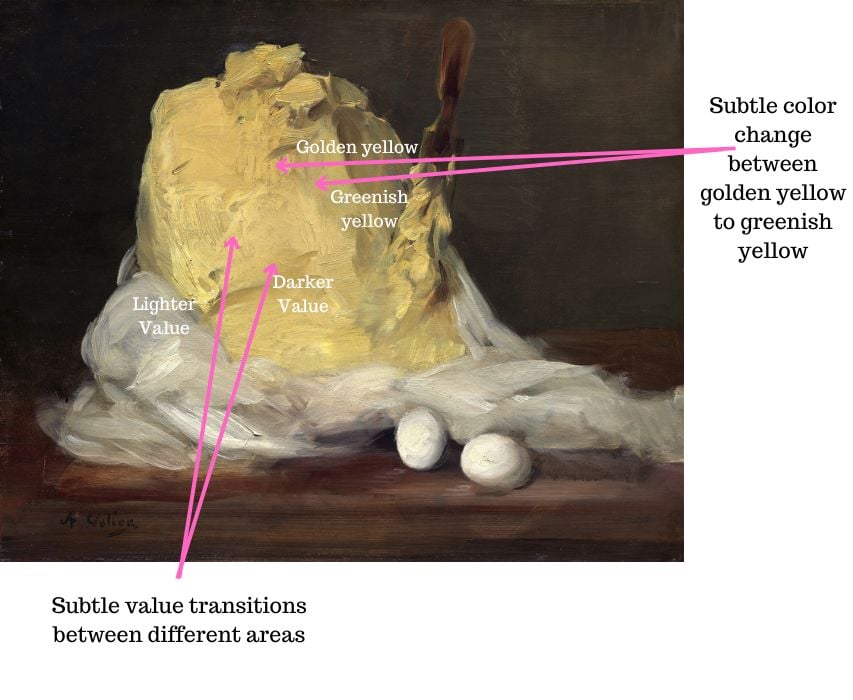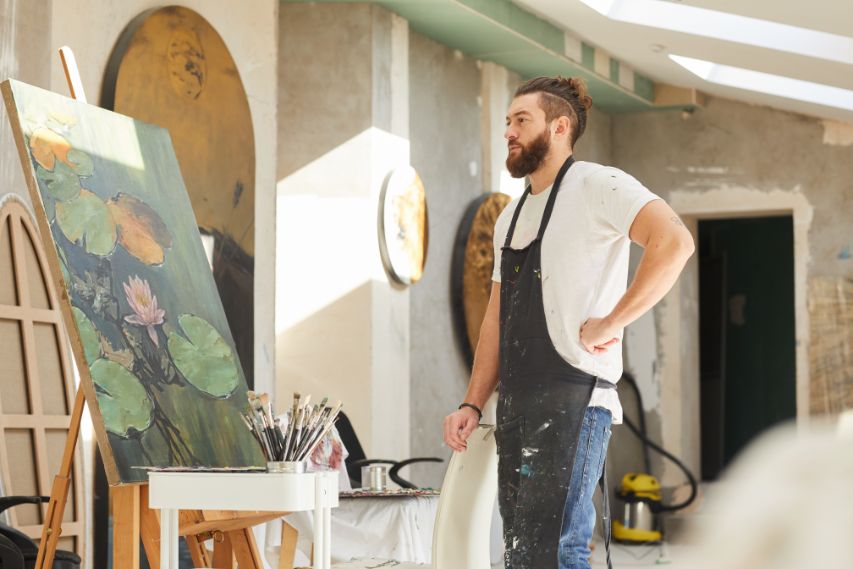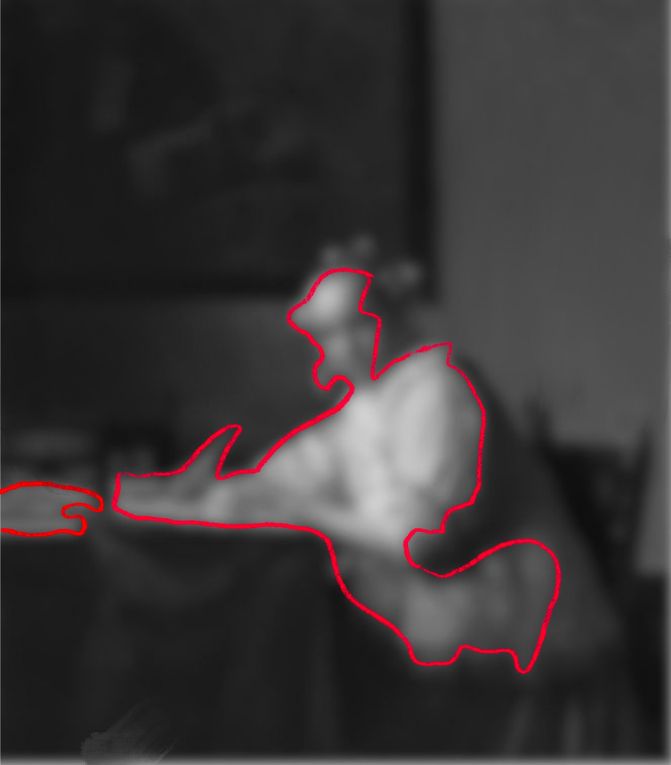Choosing the right motif for your painting can make or break its success. It’s a crucial decision that requires a deeper understanding of what a motif in art truly is. Without grasping the essence of a motif, your painting could fall short in conveying its intended message. So, let’s delve into the world of art motifs and unravel their significance.
What is a motif in art?
The word “motif” finds its roots in the word for “motive”, which means a reason (or motive) behind a person’s actions. Also in art, a motif is very similar because it is the visual subject matter of a chosen composition that is often driven by a motivating factor.

It encompasses the way that different visual elements come together, such as color, light, and shadow. However, a motif is more than just a collection of elements. It should be something that stands out to the artist and makes you excited to paint it.

For example in the painting above, the motif is about muted colors and shapes of light and dark. However, specifically it is about a distinct clear shape that is light in value. All the surrounding shapes are a little darker in value. What stood out to the artist was the distinct light value shape and how the other shapes relate to it.
How to create a good motif
You can also find incredible motifs in the most ordinary of places. For example, in the painting below the subject matter may be a large piece of butter, however the motif is all about the jagged yet smooth texture of the surface of the butter. The subtle color and value changes in the yellow slab of butter create the motif in the painting.

When choosing your motif, it’s crucial to consider what motivates you. What is the reason for painting this particular subject matter? What interests you about it?
Once you have identified your motivation, it will become easier to develop a vision for your painting and your art in general.
Reasons for choosing a motif in art
Behind every motif there is a reason. In order to create a compelling piece, there needs to be be a driving factor motivating the artist. The motif you choose is often what captures your eye most immediately.

You might look out at a landscape and see a piece of the sky lit up by the sun with contrasting darker clouds. The contrast that exists between the sliver of light in the sky and the rest of the landscape becomes your motif.
Your motif is more important than your subject matter
So, the subject matter is not what is important when it comes to a motif. It is the visual elements found within the subject matter that make a motif what it is. This is what makes a painting more than just a picture. In this case the delicate as well as abrupt changes in color and value make us see and experience the surface texture of the slab of butter.
This aspect of the painting is what stands out immediately to the viewer. Though, we are unable to ask the artist what inspired him. It is clear by how he painted it, that he was enamored with the color and value transitions in the subject.
Why a motif is essential

Finding a motif to paint is incredibly helpful to develop yourself as an artist in a multitude of different ways. For one it helps you to think more deeply about what to paint and why you are painting it. It also helps you to develop a vision for your art and yourself.
Being clear and specific
When you are specific and clear about what your motif in your paintings are, it leads to a much more profound and interesting painting for both you and the viewer. Not only does it help with creating the painting, but it also gives your work a unique voice that clearly communicates something special.

Furthermore, a motif also gives your work focus, making it much easier to create and develop. It allows you to explore different ideas but still stay within the overall theme of your painting. You can use this as a way to create a narrative that carries through all of your works. This in turn helps you to build up a strong portfolio that showcases your individual style and vision.
How to develop your vision as an artist

Not only is a motif essential in the creation of art, but it’s also essential for artists seeking to develop and grow their skills. It encourages them to think more deeply about their decision-making process.
With every motif chosen, there should be questions to ask yourself. Why am I painting this, and what do I hope to achieve from it? What message do I want to convey, and how can I best achieve that? This introspection puts artists on a path of continuous growth and improvement.

Just like Checkhov’s rule for writing, you want every element you add (or take away) to be carefully considered. A motif is no different. Choosing a motif for your art should bring out the best in your work, and it should be unique enough that it sets you apart from other artists.
Create a strong vision for your work
Developing a strong vision for every piece of art you create is not easy, but it’s important if you want to make a lasting impact with your work. Spend time studying the motifs you choose and ask yourself how each one can help to tell your story visually as an artist.
Example of a compelling motif
For example, Vermeer chose subject matter that focused more on domestic scenes. However, the motif’s he chose are all about a specific kind of clear light and simple spots of color. In this way, he transformed reality with how he created light in his paintings.

In his piece, A Lady Writing, Vermeer chose a clear distinct shape of light. While at the same time makes the rest of the painting darker in value. We can see this quite clearly when blurring the image and putting a black and white filter over it.

As shown above, the motif in his painting doesn’t have anything to do with the subject matter chosen but rather how he arranged the formal visual elements. In a painting, the subject matter merely serves as a vehicle to paint his motif and vision for his work.

The importance of a good motif
Altogether the importance of motifs in art can’t be overstated. It provides the visual elements for the composition, but more importantly, it serves as a source of inspiration for the artist.
Also, a motif motivates the artist to deliver an in-depth and personal perspective. With every motif chosen, artists have an excellent opportunity to develop their vision and grow their skills continually. No matter where you are at in your artistic career, always remember the power of a motif. Use it to create works of art that leave a lasting impact on anyone who views it.






20 thoughts on “What is a Motif in Art? Unveiling the Power of a Good Motif”
Hello Elisabeth,
Thank you for your very interesting art blog.
I always find it very hard to get a good motive for my painting.
So, now i understand a little bit more about motive and how to choose it.
Thank you for that!
Kind regards,
Frits Keulers
The Netherlands
Good to hear from you Frits! Am very glad that you found this article was helpful for you and that you found it interesting. Thank you for sharing!
Excellent post, Elizabeth. You make a good case for developing the ‘why’ of a painting.
Thank you Johanne, am glad you enjoyed this post!
I had an outstanding maths teacher who had this one philosophy: if you know why, you’ll grasp the how. This article on motive is exactly that for me. Thank you
So glad to hear this, thank you for sharing!
Thanks Elisabeth, what a topic, makes you wonder why you choose certain elements in a painting, for me it is the trees and the light plays in the bark and form as well as the idea of a road or creek leading somewhere and the distant hills with muted colours. They all play a part in luring me to paint them. It is a recurring theme I have not noticed before. maybe it is what makes painting the scenes so enjoyable.
It is indeed quite a big topic! I find myself thinking about it more and more with time. That makes quite a bit of sense – I can see how you are drawn to the motifs found in landscapes!
I never knew this!! So interesting. Thanks
You are very welcome Kelly! 🙂
Hello! Thanks for your motif in art ideas. I think this way to consider my choices while planning and painting will help me deliver my vision. I appreciate your ideas that propel me onward. Please keep them coming!
Julie Brandt
Am glad this is helpful, thank you for sharing!
Thank you Elisabeth for your clearly expressed perspective on what a motif is and its value to the artist and those who view art. This subject is new to me and is certainly food for thought. I appreciate the notion of deliberately developing a style or theme of motifs that spans over and binds together an artists body of work, differentiating it from works by other artists. You’ve got me thinking about my next painting projects! Thanks again for your guidance and sharing your expertise!
Thank you Mike, am very glad you enjoyed this article and that it helped encourage thought towards new projects!
Very thought provoking article. Thank you very much!
You are very welcome Pat!
I have always believed that the urge to create something, be it a drawing, a painting, a poem or a book is an instinctive thing that comes from within. It moulds your character, giving you a motive for living, and in my case it helped me to become a very successful manager in creating a happy, profitable workplace.
This meant that I did not have time in my working life for my other two motives for living, painting and writing, until I retired to Spain when I was 60 years old.
Since then, in the past 21 years, I have painted 140 oil paintings and written six novels.
In my painting, I have learned and developed by always looking to extend myself by painting new subjects, whilst always looking to paint portraits, which I consider to be the most difficult subject.
Thank you, Elisabeth for helping would-be artists and fulfilling our motives. Michael.
Thank you Michael for sharing your story and your thoughtful comments. It is truly my pleasure and honor to share knowledge on this website. I definitely agree with what you say and that the motive to create can come out in many different ways in our life. Am glad to hear that you have been able to to retire and work on painting and writing and really apply yourself to it fully.
This article was very interesting and demonstrates the X factor of an artist – in my opinion!
Thank you
You are so welcome Kathryn, thank you for sharing! And yes, I think you are right in that the motif’s that an artist chooses do demonstrate their X-factor.